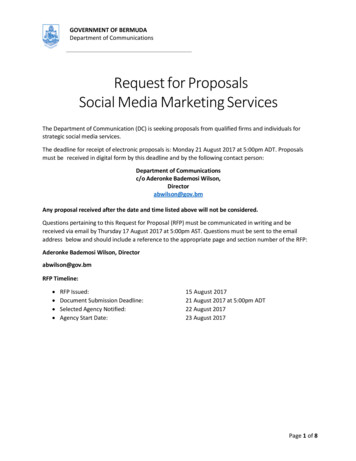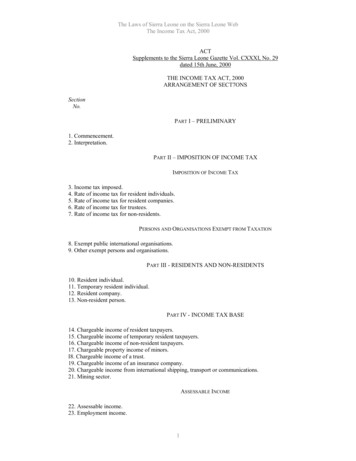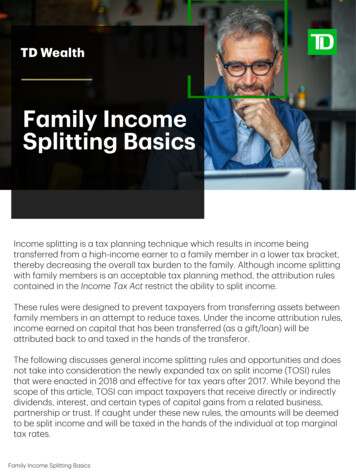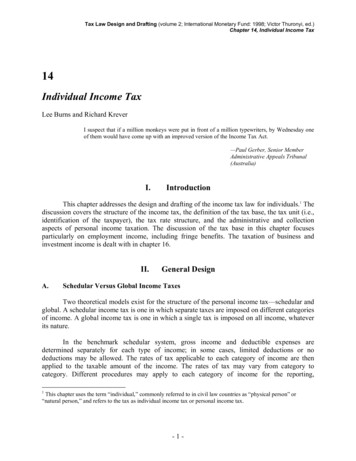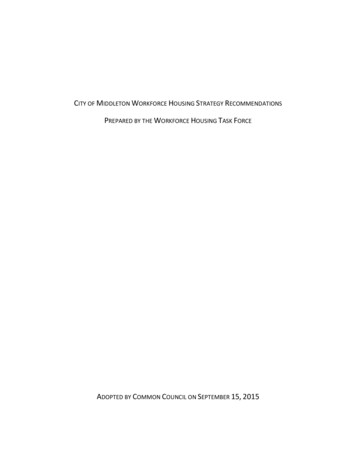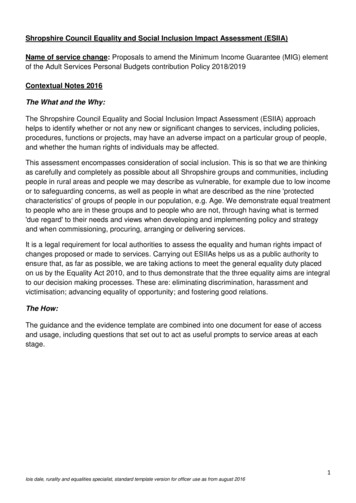
Transcription
Shropshire Council Equality and Social Inclusion Impact Assessment (ESIIA)Name of service change: Proposals to amend the Minimum Income Guarantee (MIG) elementof the Adult Services Personal Budgets contribution Policy 2018/2019Contextual Notes 2016The What and the Why:The Shropshire Council Equality and Social Inclusion Impact Assessment (ESIIA) approachhelps to identify whether or not any new or significant changes to services, including policies,procedures, functions or projects, may have an adverse impact on a particular group of people,and whether the human rights of individuals may be affected.This assessment encompasses consideration of social inclusion. This is so that we are thinkingas carefully and completely as possible about all Shropshire groups and communities, includingpeople in rural areas and people we may describe as vulnerable, for example due to low incomeor to safeguarding concerns, as well as people in what are described as the nine 'protectedcharacteristics' of groups of people in our population, e.g. Age. We demonstrate equal treatmentto people who are in these groups and to people who are not, through having what is termed'due regard' to their needs and views when developing and implementing policy and strategyand when commissioning, procuring, arranging or delivering services.It is a legal requirement for local authorities to assess the equality and human rights impact ofchanges proposed or made to services. Carrying out ESIIAs helps us as a public authority toensure that, as far as possible, we are taking actions to meet the general equality duty placedon us by the Equality Act 2010, and to thus demonstrate that the three equality aims are integralto our decision making processes. These are: eliminating discrimination, harassment andvictimisation; advancing equality of opportunity; and fostering good relations.The How:The guidance and the evidence template are combined into one document for ease of accessand usage, including questions that set out to act as useful prompts to service areas at eachstage.1lois dale, rurality and equalities specialist, standard template version for officer use as from august 2016
Shropshire Council Part 1 ESIIA: initial screening and assessmentPlease note: prompt questions and guidance within boxes are in italics. You are welcome to type over them whencompleting this form. Please extend the boxes if you need more space for your commentary.Name of service changeProposals to amend the Minimum Income Guarantee (MIG) element of the Adult ServicesPersonal Budgets contribution Policy 2018/2019:Aims of the service change and descriptionThe Adult Social Care services in Shropshire Council currently arranges care in nonresidential settings for 3,884 people in Shropshire, working with a range of providers todo so, and utilising a number of different mechanisms to help and support people tostay in their own homes for as long as they are able to.The Minimum Income Guarantee (“MIG”) is the amount that a recipient of Adult Social Careservices must be left with to pay for everyday living costs after they have contributed to thecare they receive in a non-residential setting. The statutory minimum income is 189.00 perweek for a single person and 144.30 per week for a member of a couple. People who do notmeet this are not charged for their care.Since the implementation of the Care Act 2014, the Department of Health and Social Carecircular issued each year stipulates the minimum values for the MIG. The Department ofHealth and Social Care has not increased the statutorily required MIG since 2015. On 30January 2018 the Department of Health and Social Care issued its circular advice that therewill be no changes in the level of the Minimum Income Guarantee for 2018/2019.Local authorities have the discretion to set its MIG at a higher rate than the statutory minimumif they wish to do so which allows people to keep more of their income and lessens councilincome. Shropshire Council Cabinet resolved in May 2016 that this Council would increase itsMIG rate for pension aged Service Users to 194.50 a week for a single pensioner and 148.50 for one of a couple making it higher than the governments recommendation. Thesewere 5.50 and 4.30 a week higher respectively than the legal minimum MIG set out by theDepartment of Health and Social Care. In September 2017 Cabinet resolved that during2017/18 the MIG rates would remain as per the previous year.The Councils MIG for working age people is currently set at the statutory level and noincreased allowances for any other group of service users has been made: for working ageservice users the Council have always applied the statutory minimum.The MIG affects the level of the non-residential care contribution levied by the Council, andtherefore the level of income which the Council can receive. Further detail is provided on thisbelow, but in summary, the lower the level of the MIG, the greater the income that can belevied by the Council in the form of non-residential care contributions from individuals.Shropshire Council, like other local authorities, is facing a significant increase in the cost ofadult social care due to increasing demand, demographic pressures and rising contract costs;the cost of adult social care purchasing expenditure is forecast to increase by an average of8% per year over the next five years.As a large and sparsely populated rural authority with a significantly older age profilethan the all-England average, these costs are exacerbated by the additional costs of2lois dale, rurality and equalities specialist, standard template version for officer use as from august 2016
commissioning, arranging and delivering social care and other Council services tohouseholds across the county. The Council already works closely with other ruralauthorities and through MPs to make the case to Government for fairer funding in thelight of sparsity factors, but is also required as a matter of financial prudence to takesteps to ensure that income is maximised in ways that are fair and transparent as wellas utilised in ways that will seek to benefit communities in ShropshireIt is proposed that two options for retaining or reducing the current level of MIG are consultedupon.Option 1 - Retain existing MIG and increase care contributions in line with benefitsincreases.Option 1 would effectively cancel out a service user’s increased pension. A single olderperson receiving pension credit would receive a weekly increase of 7.15 in their income, andtheir contribution would increase by 6.39, leaving them with typically 76p additional incomeper week. One of a couple would receive 4.43 additional pension but would incur increasedcharges of 4.01, leaving them with typically 42p additional income per week. Therefore, ifShropshire Council’s MIG were to remain the same as in 2017/12018, the financialconsequence for those over retirement age would be that their weekly increase in pensionwould be absorbed almost entirely by the increase in their contribution to their care andsupport.This option would generate an estimated additional income of approximately 250,000 perannum for the Council.Option 2 – Change the level of the Minimum Income Guarantee to the level set by theGovernment. This will mean people receiving care will have to pay a little more towardsthat care.People affected by the changes would keep less of their money because more will go towardscare. For example, rather than have 76 pence extra, as in Option 1, a single person will have 4.74 a week less and a couple will have 3.35 a week less. This option will mean people willhave less income than option 1 but it would mean Shropshire Council will have an extra 467,000 each year to help towards providing care and support to those who need it most.The Minimum Income Guarantee for people of working age is already set at the Governmentminimum level. Option 2 would mean people of pensionable age are treated in the same wayas people of working age.All those affected by the above proposals will be contacted as part of the formal consultation.Intended audiences and target groups for the service changeThis will be the general public; those who are currently receiving care at home or in thecommunity and of pensionable age who will be impacted by any changes to theMinimum Income Guarantee; their carers; those who receive care who are of workingage; and their carers.3lois dale, rurality and equalities specialist, standard template version for officer use as from august 2016
Evidence used for screening of the service change Statistics about the rurality of the County, its ageing population in statisticalterms, and reference to the costs of arranging and providing services in a largerural county.Any known evidence about the protected characteristic groupings of people whowill be impacted by any changes to the MIG and of pensionable age, i.e. not justtheir age.Reference that there are around 1300 people currently who would be impactedby any changes to MIG and of pensionable ageNumbers who are single and numbers who are in couplesNumber this is expected to increase to over next five years to give perspectiveon the growth of this group and thus more weight to the rationale for theproposed service changeNumbers of working age who are receiving care and support at home or in thecommunity in order to facilitate comparisons and give an overall picture.Specific consultation and engagement with intended audiences and target groups forthe service change Individual households, whether single people or couples, for whom there isconsidered to be an impact either now or in the futureAll those who would be affected by any changes to the MIG in Shropshire at themomentShropshire Council councillorsMPsVCSATown and parish councilsHealth and social care providersShropshire Business Board and Marches LEPThis list is not intended to be exhaustive and will be amended and added to asappropriate, including as arrangements for consultation are further developed.4lois dale, rurality and equalities specialist, standard template version for officer use as from august 2016
Potential impact on Protected Characteristic groups and on social inclusionUsing the results of evidence gathering and specific consultation and engagement, pleaseconsider how the service change as proposed may affect people within the nine ProtectedCharacteristic groups and people at risk of social exclusion.1. Have the intended audiences and target groups been consulted about: their current needs and aspirations and what is important to them; the potential impact of this service change on them, whether positive or negative,intended or unintended; the potential barriers they may face.2. If the intended audience and target groups have not been consulted directly, have theirrepresentatives or people with specialist knowledge been consulted, or has researchbeen explored?3. Have other stakeholder groups and secondary groups, for example carers of serviceusers, been explored in terms of potential unintended impacts?4. Are there systems set up to: monitor the impact, positive or negative, intended or intended, for different groups; enable open feedback and suggestions from a variety of audiences through avariety of methods.5. Are there any Human Rights implications? For example, is there a breach of one or moreof the human rights of an individual or group?6. Will the service change as proposed have a positive or negative impact on: fostering good relations? social inclusion?5lois dale, rurality and equalities specialist, standard template version for officer use as from august 2016
Initial assessment for each groupPlease rate the impact that you perceive the service change is likely to have on a group, through insertinga tick in the relevant column. Please add any extra notes that you think might be helpful for readers.Protected Characteristic Highgroups and othernegativegroups in ShropshireimpactPart TwoESIIArequiredAge (please include children, youngHighpositiveimpactPart OneESIIArequiredMediumpositive ornegativeimpactPart One ESIIArequiredXLow positiveor negativeimpactPart OneESIIArequiredpeople, people of working age, olderpeople. Some people may belong tomore than one group eg child for whomthere are safeguarding concerns egolder person with disability)Disability (please include: mentalXhealth conditions and syndromesincluding autism; physical disabilities orimpairments; learning disabilities;Multiple Sclerosis; cancer; HIV)Gender re-assignmentX(please include associated aspects:safety, caring responsibility, potentialfor bullying and harassment)Marriage and CivilPartnership (please includeXassociated aspects: caringresponsibility, potential for bullying andharassment)Pregnancy & MaternityX(please include associated aspects:safety, caring responsibility, potentialfor bullying and harassment)Race (please include: ethnicity,Xnationality, culture, language, gypsy,traveller)Religion and belief (pleaseXinclude: Buddhism, Christianity,Hinduism, Islam, Judaism, Nonconformists; Rastafarianism; Sikhism,Shinto, Taoism, Zoroastrianism, andany others)Sex (please include associatedXaspects: safety, caring responsibility,potential for bullying and harassment)Sexual Orientation (pleaseXinclude associated aspects: safety;caring responsibility; potential forbullying and harassment)Other: Social InclusionX(please include families and friendswith caring responsibilities; people with6lois dale, rurality and equalities specialist, standard template version for officer use as from august 2016
health inequalities; households inpoverty; refugees and asylum seekers;rural communities; people for whomthere are safeguarding concerns;people you consider to be vulnerable)Guidance on what a negative impact might look likeHigh Significant potential impact, risk of exposure, history of complaints, no mitigatingNegative measures in place or no evidence available: urgent need for consultation withcustomers, general public, workforceMedium Some potential impact, some mitigating measures in place but no evidenceNegative available how effective they are: would be beneficial to consult with customers,general public, workforceLow Almost bordering on non-relevance to the ESIIA process (heavily legislation led,Negative very little discretion can be exercised, limited public facing aspect, national policyaffecting degree of local impact possible)Decision, review and monitoringDecisionPart One ESIIA Only?YesXProceed to Part Two FullReport?NoxPlease now use the boxes below and sign off at the foot of the page.Actions to mitigate negative impact or enhance positive impact of the service changeThe proposed changes, whether option 1 or option 2, are acknowledged to be likely tobe considered to have a negative impact across the Protected Characteristicgroupings, particularly the groupings for Age, Disability, and Social Inclusion, withregard to those currently of pensionable age who would be impacted by any changesto the Shropshire MIG and their carers; those who will enter this age group in thefuture; those with associated disabilities including seen and unseen disabilities; andthose who are at risk of social inclusion such as low income households, householdswhere members have caring responsibilities, and rural households for whom there aregreater costs associated with accessing facilities and services. It is possible that therewill also be future mental health care needs that could arise from placing real orperceived financial stress on a household as a result of changes to the way the MIG isapplied.All other groupings are currently assessed to show a low negative impact inrecognition that this service change will cut across all groupings.7lois dale, rurality and equalities specialist, standard template version for officer use as from august 2016
Efforts will be made during consultation on the proposals to seek views fromcommunities as well as from service users and stakeholders.Draft consultation documents and survey have been shared with service users for theirfeedback and comments. As a result of feedback changes have been made to the wayinformation is presented, to the type of survey that will be issued, and in the design ofthe survey.Please note- as consultation has not yet taken place actions to mitigate negativeimpact or enhance positive impact will depend upon decisions to be taken by CabinetInitial actions identified to date are as follows:-undertake full consultation to allow people to share the concerns and impacts that thechange will have- ensure concerns are fully logged and reported to Cabinet to inform the final decision if thechange is going to be implementedIt is recognised that there will then need to be ongoing efforts to engage with people inthe Protected Characteristic groupings, particularly where low levels of responses topublic consultation are received. Links may usefully also be made with specific targetgroups including older people, people with mental health problems, and people withphysical disabilities, through projects and partnership initiatives already under wayand through work with advocates. Actions may then be more readily identified fromevidence gathered to mitigate the likely negative impact of the Strategy for thesegroupings, leading to better outcomes overall for communities in Shropshire.Actions to review and monitor the impact of the service changeIt is recognised that there will need to be clear communication and consistentmessaging by the Council about where and how additional income to the Councilwould be utilised in provision of services, including geographical spread. People arebeing advised of changes that would impact on their personal finances, and they mayconsider that they are no longer perceiving personal benefit, in whichever of theOptions being consulted upon. It will therefore be important for the Council toarticulate and to emphasise the rural realities of arranging and providing adult socialcare services in what is the second largest inland county in England, and to set out inas much detail as may be possible where the additional money accruing to the Councilis intended to be spent for the maximum benefit of these households, who may nototherwise perceive any tangible benefit.Further actions will be identified following the public consultation, and developed inliaison with Shropshire Council councillors and with MPs as representatives of their8lois dale, rurality and equalities specialist, standard template version for officer use as from august 2016
communities.The Council will also share approaches with other local authorities including ruralcounty authorities through organisations such as the County Councils Network and theRural Services Network, in order to identify and develop best practice and to continueto make the case to Government for fairer funding for rural communitiesScrutiny at Part One screening stagePeople involvedLead officer carrying out thescreeningSignaturesDateAny internal support*30th April 2018(commentary in boldand italics)Any external support**Mrs Lois DaleRurality and EqualitiesSpecialistHead of service*This refers to other officers within the service area**This refers either to support external to the service but within the Council, eg from the Rurality andEqualities Specialist, or support external to the Council, eg from a peer authoritySign off at Part One screening stageNameLead officer’s nameSignaturesDateHead of service’s name9lois dale, rurality and equalities specialist, standard template version for officer use as from august 2016
Proposals to amend the Minimum Income Guarantee (MIG) element of the Adult Services Personal Budgets contribution Policy 2018/2019: Aims of the service change and description The Adult Social Care services in Shropshire Council currently arranges care in non-residential settings for 3,884 people in Shropshire, working with a range of providers to





